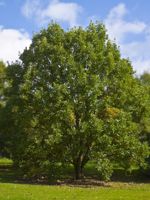Mon-Fri 9am - 5pm Mountain time
Common Hackberry vs Schuettes Oak
Celtis occidentalis
Quercus × schuettei (Quercus bicolor × Quercus macrocarpa)
NOT AVAILABLE THIS SEASON - MIGHT RETURN
The Common Hackberry is a medium-sized deciduous tree that resembles the American Elm but is immune to Dutch Elm Disease. They are versatile and can adapt to a variety of growing conditions.
It produces purple-red, berry-like fruit with a large seed in the center. Both the sweet flesh, which tastes similar to dates, and the crunchy seed are edible. The fruit remains on the tree throughout the winter, offering a valuable food source for birds and other wildlife.
The Common Hackberry can also be a great addition to a pollinator garden. The tree itself is a host for the larvae of several butterfly species and the flowers provide a source of pollen and nectar.
Schuettes Oak is a naturally occurring hybrid of Swamp White Oak and Bur Oak. With a faster growth than both parent species, it is one of the fastest growing Oak trees. They are known for growing very large and wide, so space them appropriately. It is considered one of the most adaptable Oaks with little preference on soil conditions. It can handle growing in wet, saturated soils as well as those that are dry, clay, or alkaline.
The Schuettes Oak has very large acorns. They have a large cup portion like the Bur Oak, but without the fringe. Due to the Swamp White Oak parentage, the acorns have less tannins and a sweeter taste. They are a food source for various wildlife including birds, squirrels, and deer.
Common Hackberry Quick Facts
Schuettes Oak Quick Facts
Toxicity: when injested, can be toxic for many animals

